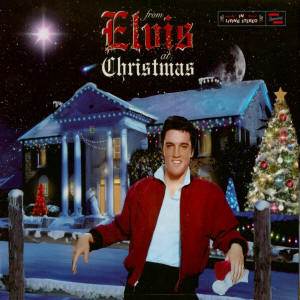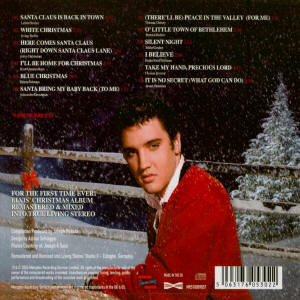

On October 18, 2024 the Memphis Recording
Service released an album called "From Elvis At
Christmas". It's a single compact disc, housed
in a 5" hardcover digipak, but in contrast to
their previous outings without a booklet. Of
course the album is also available on the
various streaming platforms.
According to the cover we get to hear "Elvis'
Christmas Album" remastered and mixed into True
Living Stereo for the first time ever. Maybe "True Living Stereo" is
some kind of trademark and therefore the claim
might be true, but it's definitely not the first
stereo incarnation of the original mono tracks.
In fact RCA issued their first "fake stereo"
albums as early as 1961. Three Toscanini
longplayers were upgraded with the label's own
ESR (Electronic Stereo Reprocessing) technology
and sold much better than the original mono
editions. At the time stereo was the new
standard for all recordings and the old
monaural sound was considered to be outdated.
Even though RCA's ESR technology sounded fine,
the label switched to a variation called ERS
(Electronically Reprocessed Stereo) in 1962.
This procedure quickly became the norm and RCA
soon re-released their complete mono catalogue
(including the five Presley albums of the 1950s)
in a new "fake stereo" incarnation. Everyone
wanted multi-channel sound and so RCA was able
to sell the old stuff a second time. When the
production of mono releases was stopped in 1968,
the ERS incarnations became the only available
versions of older albums. With some distance
more and more people realized, that the original
mono editions sounded much better than the
"noisy" fake versions, but it took the major
labels until the 1990s (!) to re-issue the
material the way it was recorded. To make a long
story short: "From Elvis At Christmas" certainly
isn't the first stereo incarnation of "Elvis'
Christmas Album".
Back in the old days the fake stereo effect
was archived by copying two separate mono
signals in two separate stereo channels. The
highs in one channel were stressed, while the
lows in the other channel were stressed. Both
channels were delayed a fraction of a second,
the "hole" between the two channels was filled
with reverberation and echo. Of course today's
AI tools also copy the original monaural signal,
but additionally they also can filter certain
elements and place them on the sound stage
whereever the engineer wants them to be. Besides
that, there are far more opportunities to
emphasize on sound elements or eleminate them
(at least to a certain degree).
From 2021 onwards the Memphis Recording
Service has re-released several concert
recordings. While Sony's own collector's label
(Follow That Dream Records) puts the material
out in their original mono version, their
competitor opts to beef them up with a fake
stereo sound. The results are mixed, especially
the recordings of lesser quality sound better in
their original form. Somehow the "stereo"
treatment seems to emphasize on the distortions.
However, if the audio quality of the original
mono recording is good, MRS's treatment makes
them sound even better.
So what about "Elvis' Christmas Album"?
The original mono recordings sound tighter, but
the new version adds some space to the music and
sounds a bit fuller, more modern. One might say
that Memphis Recording Service archieved, what
RCA once longed for with their ERS technology.
Santa Claus Is Back In Town!
In this great, bluesy song Santa arrives in a
black Cadillac and it's up to the imagination of
the listener what is meant by "Hang
up your pretty stockings and turn off the light
- Santa Claus is comin' down your chimney
tonight". Obviously Jerry
Leiber and Mike Stoller completely satisfied the
wish to deliver a song suitable for the image of
the king of rock'n'roll. "Santa Claus Is Back In
Town!" was recorded on September 7, 1957 within
seven takes. RCA Victor also released the track
on the ep "Elvis Sings Christmas Songs" (1957)
and the single "Santa Claus Is Back In Town!" /
"Blue Christmas" (1965).
White Christmas
The song premiered on the first Christmas day of
1941, when Bing Crosby performed it on his radio
show "The Kraft Music Hall". On May 29th of the
following year he recorded it with the John
Scott Trotter Orchestra and The Ken Darby
Singers within 18 minutes and released it on
July 30th on the album "Songs From The Film
Holiday Inn". To Crosby "White Christmas" wasn't
anything special, but in 1942 it peaked at the
number one of the Billboard Charts and stayed
there for no less than 11 weeks. With sales of
over 50 million units it's regarded to be the
most successful single release of all time.
Countless artists have covered "White
Christmas", Elvis did it on September 6, 1957
and needed nine takes. It is said that Irving
Berlin, the writer of the song, disliked the
king's version so much, that he asked the radio
stations to boycott the recording. Even though
Berlin's reaction was ridiculous, I cannot help
to agree to his general criticism. Elvis'
version simply lacks all festiveness and
emotional depth I expect of a performance of
this song. By 1957 he simply lacked the
technique and the wealth of experience to do it
right. RCA Victor also released "White
Christmas" on the ep "Christmas With Elvis"
(1958).
Here Comes Santa Claus (Right Down Santa
Claus Lane)Elvis recorded this nice
uptempo song on September 6, 1957 within two
takes. He really delivered a great performance,
very snappy and catchy. The first version was
recorded in 1947 by Gene Autry, who had written
"Here Comes Santa Claus (Right Down Santa Claus
Lane)" with Oakley Haldeman. RCA Victor used the
king's version also on the extended player
"Christmas With Elvis" (1958).
I'll Be Home For Christmas
Bing Crosby sang this song in 1943 and portrayed
a soldier, who promises his family to be back
home for Christmas. It turns out that it's
nothing but wishful thinking when he sings at
the end "I'll be home for Christmas, if only in
my dreams". Elvis' version, recorded on
September 7, 1957 within 15 takes, certainly is
ok, but it lacks the depth a song of this kind
requires. "I'll Be Home For Christmas" was
written by Kim Gannon and Walter Kent. To avoid
a legal dispute with Buck Ram, who had written a
song of the same title, Gannon and Kent credited
him and therefore gave him a third of their
royalties. RCA Victor also released Elvis'
recording on the ep "Elvis Sings Christmas
Songs" (1957).
Blue ChristmasThe
rock'n'roll king put this one on tape within
three takes on September 5, 1957. RCA Victor
released it on the ep "Elvis Sings Christmas
Songs" (1957), the singles "Blue Christmas" /
"Wooden Heart" (1964) and "Santa Claus Is Back
In Town!" / "Blue Christmas" (1965) and the
album "A Legendary Performer - Volume 2" (1976).
A live recording is featured on the album
"Elvis" (1968). The song was written by Bill
Hayes and Jay Johnson, the first recorded
version was done by Doye O'Dell. It finally got
popular by cover versions of Ernest Tubb, Hogo
Winterhalter & His Orchestra and Russ Morgan &
His Orchestra.
Santa Bring My Baby Back (To Me)
This song ends the a-side of the album. The
catchy uptempo popsong was written by Aaron
Schroeder and Claude DeMetrius, but even though
it was often played by the radio djs, RCA Victor
only released it on a single in Great Britain.
It was quite successful and made it in the top
10 of the UK Charts. Elvis recorded "Santa Bring
My Baby Back (To Me)" on September 7, 1957
within nine takes. His recording was also
released on the extended player "Elvis Sings
Christmas Songs" (1957).
Peace In The ValleyOn
January 6, 1957 Elvis had surprised his audience
when he performed the gospel "Peace In The
Valley" on "The Ed Sullivan Show". Seven days
later he recorded it in the studio within nine
takes. Originally Thomas A. Dorsey had written
the song for Mahalia Jackson, but the big hit
was by Red Foley & The Sunshine Boys. Their
version made it to number 7 on the "Country &
Western Charts" in 1951 and became the first
gospel record that sold more than a million
copies. I am known for disliking most of the
ballads Elvis recorded in his early days, but
"Peace In The Valley" is the big exception. His
voice sounds nothing but great and he performs
with depth, warmth and believable feelings. RCA
Victor had released "Peace In The Valley" on an
extended player of the same name, in 1971 it was
also featured on the CAMDEN album "You'll Never
Walk Alone".
O Little Town Of Bethlehem
The song was written in 1868 by Phillips Brooks
and Lewis Redner and first recorded by The
Trinity Choir in 1916. Elvis did so on September
7, 1957 and needed four takes to create a
satisfactory version. He certainly sings well,
but by 1957 he was way better on the uptempo
stuff. RCA Victor released "O Little Town Of
Bethlehem" in 1958 on the ep "Christmas With
Elvis".
Silent NightThis is an
adaptation of "Stille Nacht, Heilige Nacht", a
song written by Joseph Mohr and Franz Xaver
Gruber in 1818. Today this composition is
regarded to be the most famous of its kind and
was declared "world heritage" by the UNESCO in
2011. Even though I am not religious, this is my
favorite piece of music. No other song is so
solemn, moving and beautiful like this.
Unfortunately Elvis' performance doesn't evoke
any emotions, it simply lacks depth and
feelings. In 1958 RCA Victor also used "Silent
Night" on the extended player "Christmas With
Elvis".
I Believe
The same applies to "I Believe". Elvis recorded
it on January 12, 1957. Take 9 was selected as
the master. The king surely sings it well, but
he certainly would have done it better a few
years later. Erwin Drake, Irvin Graham, Jimmy
Shirl and Al Stillman had written "I Believe" in
1953 for Jane Froman. The song was covered by
many great artists like Perry Como, Dolly Parton
and Frank Sinatra.
Take My Hand, Precious Lord
This one was also written by Thomas A. Dorsey.
At least, that's what the copyright claims,
because the melody is based on a hymn by George
Nelson Allen called "Maitland". The Heavenly
Gospel Singers were the first to record "Take My
Hand, Precious Lord" way back in 1937. On
January 13, 1957 Elvis needed 14 attempts to do
so. RCA Victor released the track on the ep
"Peace In The Valley", CAMDEN used it on the
album "You'll Never Walk Alone" (1971).
It Is No Secret (What God Can Do)
Like all gospel songs on this album, this one,
too, was first released on "Peace In The Valley"
and later on "You'll Never Walk Alone". Elvis
recorded "It Is No Secret (What God Can Do)" on
January 19, 1957 within 13 takes. The songs was
written by Stuard Carl Hamblen, who also
recorded it in 1950.
Verdict
Memphis Recording Service managed to beef
up the original "Elvis' Christmas Album" and
make it sound a bit more modern. "From Elvis
At Christmas" is no replacement, but
certainly a nice upgraded alternative.

(C) Memphis
Recording Service
![]()

